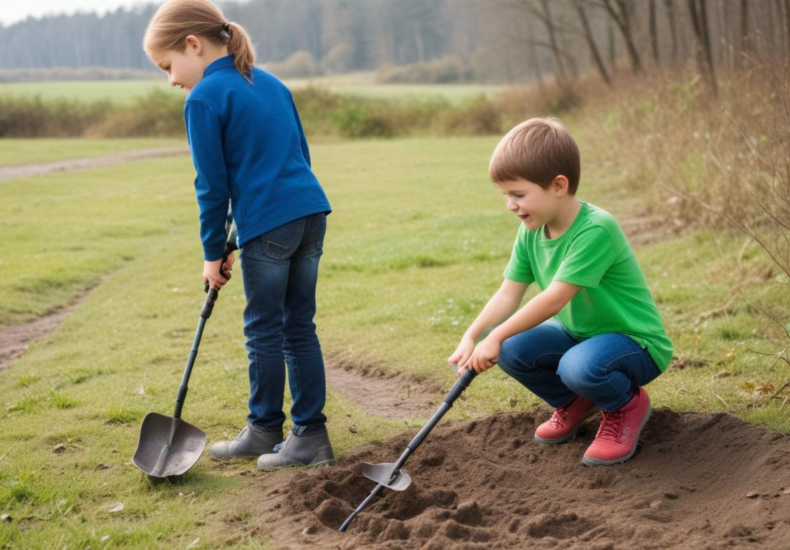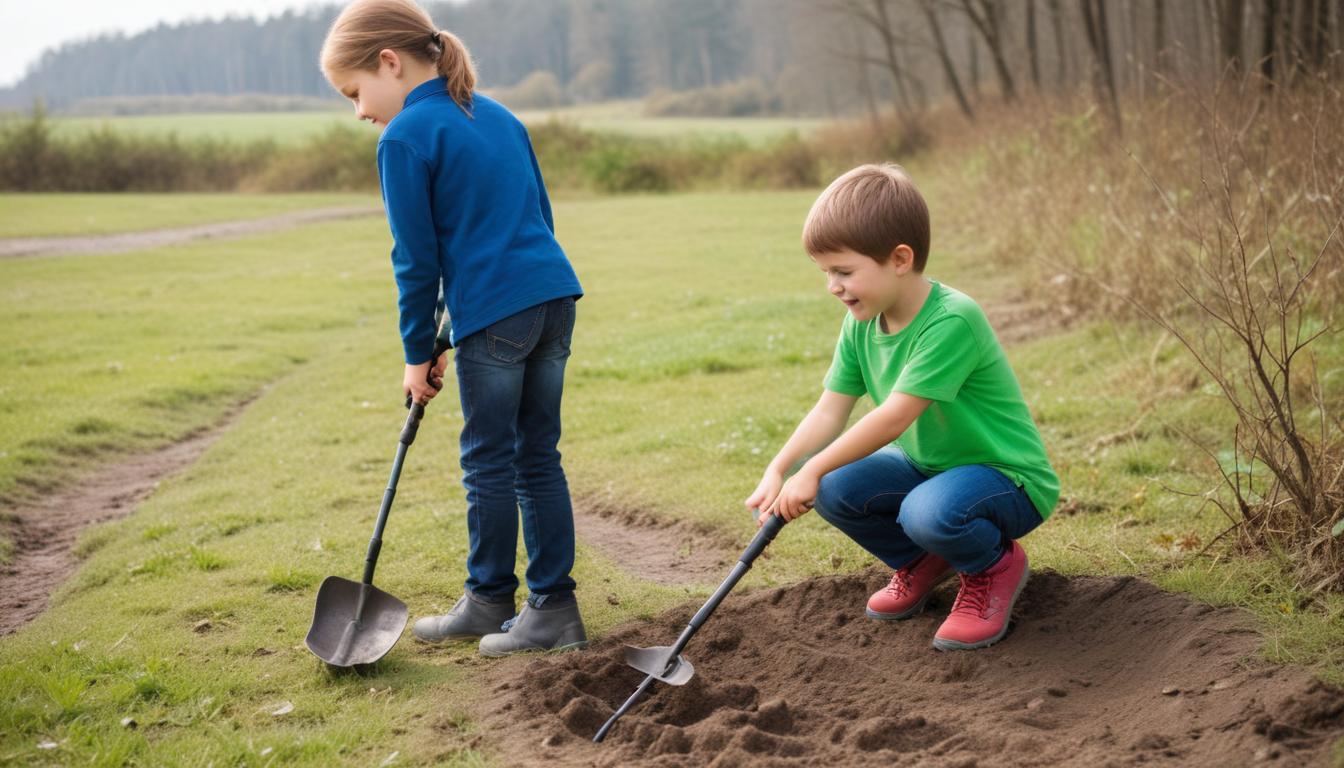
How to get kids excited about metal detecting
When selecting a metal detector for kids, it’s crucial to consider both the child’s age and their level of interest in this engaging hobby. For younger children, aged between 4 and 8, choose lightweight models designed specifically for kids, which often feature adjustable handles, simple controls, and colorful designs. These detectors are not only easier for little hands to manage but also make the experience more fun and less intimidating.
For older children and pre-teens, consider a model that offers slightly more advanced features while still being easy to use. This not only maintains their interest in the hobby but also adds an educational layer, helping them learn about different types of metals and the basics of electromagnetic theory. Look for detectors that allow for sensitivity adjustment and discrimination between different types of metals. Tools with a digital display can also provide useful feedback that enhances the learning experience and adds depth to their exploration.
Durability is another important factor. Kids are often rough with their toys and gadgets, so choosing a metal detector that can withstand some bumps and drops is essential. Waterproof features are also beneficial, especially if your family’s detecting adventures might include beaches or muddy areas.
Engaging kids in this hobby is also about ensuring that the experience is enjoyable and comfortable for them. Select a detector with a comfortable handle and a lightweight design so that they can search for treasures without quickly tiring. Furthermore, consider a model that comes with headphones to make it easier for kids to hear the beeps even in noisy environments—turning each outing into an exciting adventure that sharpens their attention and listening skills.
Ultimately, the right metal detector for a kid should balance ease of use, educational value, and fun. By choosing wisely, you can ignite a passion for exploring and learning that might blossom into a lifelong hobby, enriching your family’s outdoor activities and providing educational opportunities along the way.
Setting up a treasure hunt
Setting up a treasure hunt can be the perfect way to spark interest in metal detecting as a family hobby. Start by selecting a location that is safe and suitable for kids, such as your own backyard, a local park, or a beach, ensuring you have the necessary permissions if required. The setting plays a crucial role in the hunt’s success, as it should offer a mix of challenge and accessibility to keep the kids engaged but not discouraged.
Next, prepare the treasure hunt by burying small items that the children will find exciting to discover. These can range from inexpensive costume jewelry and old coins to small toys or custom-made tokens. Make sure the items are not too deep so that they are detectable by the kid-friendly metal detectors and won’t require too much digging, which might tire the younger participants quickly.
To add an educational twist, each find could be linked to interesting historical facts or stories. For instance, an old coin can prompt a mini-lesson about the era it came from, turning a simple find into a valuable history lesson. This helps deepen the kids’ understanding of the past and enhances the educational value of the hobby.
During the treasure hunt, encourage the children to take turns using the metal detector. This teaches them about sharing and teamwork, as they help each other uncover and retrieve the items. To keep the excitement high, consider setting up small rewards for each find, such as stickers or points leading to a prize, making the effort feel rewarding and fun.
Throughout the activity, ensure all participating family members are aware of the basic metal detecting etiquette and safety tips, such as wearing gloves when digging and avoiding areas that might be unsafe or restricted. Supervision by adults is critical, especially in public or unfamiliar areas, to maintain the safety and well-being of all treasure hunters involved.
By combining fun, education, and family bonding, setting up a treasure hunt provides a wholesome introduction to the hobby of metal detecting. It encourages outdoor activity, piques curiosity about history, and cultivates patience and perseverance among young enthusiasts.
Learning about history through found objects
Exploring with a metal detector not only brings immediate excitement to kids but also opens a unique avenue for education, particularly in history. When a child unearths an object, whether it’s an old coin, a rusty buckle, or a fragment of pottery, it becomes a tangible piece of the past right in their hands. This direct engagement with historical artifacts significantly enhances their learning and interest in history.
For example, discovering a Civil War bullet can lead to a fascinating discussion about the conflicts of the era, the soldiers’ lives, and how the war shaped the nation. Similarly, finding a coin from the early 20th century might prompt a mini-history lesson on the economic conditions of that time or the technological advancements that led to changes in metal compositions used in coins.
Such finds are not merely objects; they are gateways to stories and eras gone by. Parents and educators can seize these opportunities to dive deeper into the educational aspects, connecting the dots between the found objects and historical facts. Local libraries or online databases can enhance this learning experience, providing detailed contexts about the periods from which these objects originate.
Incorporating this educational dimension into the kids’ hobby of metal detecting enriches their understanding and appreciation of history, making it lively and interactive. Instead of passive learning from books, they engage actively with history, solving the puzzles of the past with each find. This method not only helps in retaining historical knowledge but also develops critical thinking and research skills as they seek to learn more about their discoveries.
Encouraging children to document their finds in a scrapbook or digitally can further enhance the learning experience. They could write small reports or create presentations about the significance of each item, fostering a deeper connection with history and polishing their communication skills. Such activities make the culmination of a day spent in family detecting not just about what was found, but also about the knowledge gained and shared.
The educational benefits of this hobby therefore extend far beyond simple recreation. It is an enriching pursuit that combines physical activity, teamwork, and intellectual growth. Whether in a historical site or their own backyard, children equipped with metal detectors are on a quest not just for objects, but for knowledge and insights that bring history vividly to life.
Metal detecting safety tips for families

While metal detecting is a fun and educational family activity, it’s essential to prioritize safety to ensure a positive experience for everyone involved. First and foremost, outfitting your family in the appropriate attire is key. Ensure that everyone wears sturdy footwear to protect their feet from sharp objects, and consider long pants to guard against scratches when navigating through underbrush or other rough terrain.
Sun protection is another critical aspect, especially during long hours outdoors. Hats, sunglasses, and a good application of sunscreen will help protect against sunburn and heatstroke. Remember to encourage regular breaks and carry plenty of water to keep everyone hydrated.
Metal detector handling itself also demands certain precautions. Teach children how to properly use and carry their detectors to prevent accidental injuries. Metal detectors should always be swung slowly and deliberately to avoid hitting someone nearby. Furthermore, ensure that your kids understand the importance of handling found objects carefully. Some items might be sharp, rusty, or otherwise hazardous, so wearing gloves can prevent cuts or infections.
To avoid trespassing or venturing into potentially dangerous areas, always check local laws and regulations concerning metal detecting, and only explore areas that are known to be safe and allowed by the authorities. It’s also wise to carry a first aid kit and have a mobile phone handy for emergencies, especially in more secluded locations.
Responsible metal detecting also involves respecting the environment. Teach your children to fill in any holes they dig and to dispose of any trash they may unearth or encounter. This not only protects wildlife and maintains the beauty of natural spaces but also sets a good example of environmental stewardship for your children.
The most important aspect, however, is supervision. Never let children metal detect alone. Adult supervision ensures that kids remain safe and that they learn responsible detecting habits. Supervising offers a fantastic opportunity to discuss the significance of their finds, deepening their education and enhancing their excitement about this enriching family detecting activity.
By following these safety guidelines, metal detecting can be an engaging, educative, and secure hobby for the whole family. With the proper knowledge and tools, parents can foster a safe environment that enhances both the fun and the learning experience, making those treasure-hunting excursions memorable and worry-free.
Celebrating and displaying finds
Celebrating each successful metal detecting expedition is crucial in maintaining the enthusiasm and engagement of young treasure hunters. One effective way to preserve the magic of these discoveries is by creating a display area at home where kids can showcase their finds. This not only acknowledges their efforts and skills but also instills a sense of pride in their accomplishments. A simple shelf or a designated corner in their room can serve as an excellent spot for this purpose. Kids can arrange their found treasures, such as old coins, interesting rocks, or antique relics, alongside labels or small plaques that describe each item’s significance or the story behind its discovery.
Another engaging activity is to host a “show and tell” session where children can share their finds with family and friends. This not only allows them to express their knowledge and experiences but also enhances their communication skills. During these sessions, the excitement of recounting their adventure can rekindle interest in their finds and may even inspire others to take up this exciting family hobby. To add an educational dimension, parents can encourage their children to research their finds and present their historical or cultural significance, making the experience both educational and entertaining.
Creating a scrapbook or a digital slideshow can also be a fun project that documents these adventures in metal detecting. Kids can take photos of their finds, both at the discovery site and after cleaning and identifying them. Accompanying each photo with a story or factual information turns a simple album into an educational resource that chronicles their journey in the hobby of metal detecting. This kind of documentation is not only a great way to celebrate the successes but also serves as a personalized historical record that they can look back on with pride.
For many families, participating in metal detecting clubs or online forums can also be rewarding. These platforms allow kids to share their discoveries, gain insights from experienced metal detectors, and even participate in community events. Such interactions can enhance their understanding of metal detecting and offer further opportunities for celebrating their finds through community recognition and possibly even competitions.
Ultimately, each of these activities supports celebrating and displaying finds in a way that enhances the educational value of the hobby. It motivates continuous learning and excitement, ensuring that metal detecting remains a cherished part of family life and learning development. Through these celebration methods, the hobby of metal detecting transcends beyond just searching for items; it becomes a shared journey of discovery, learning, and personal growth for everyone involved.
You may also like
Archives
Calendar
| M | T | W | T | F | S | S |
|---|---|---|---|---|---|---|
| 1 | 2 | |||||
| 3 | 4 | 5 | 6 | 7 | 8 | 9 |
| 10 | 11 | 12 | 13 | 14 | 15 | 16 |
| 17 | 18 | 19 | 20 | 21 | 22 | 23 |
| 24 | 25 | 26 | 27 | 28 | 29 | 30 |
Leave a Reply